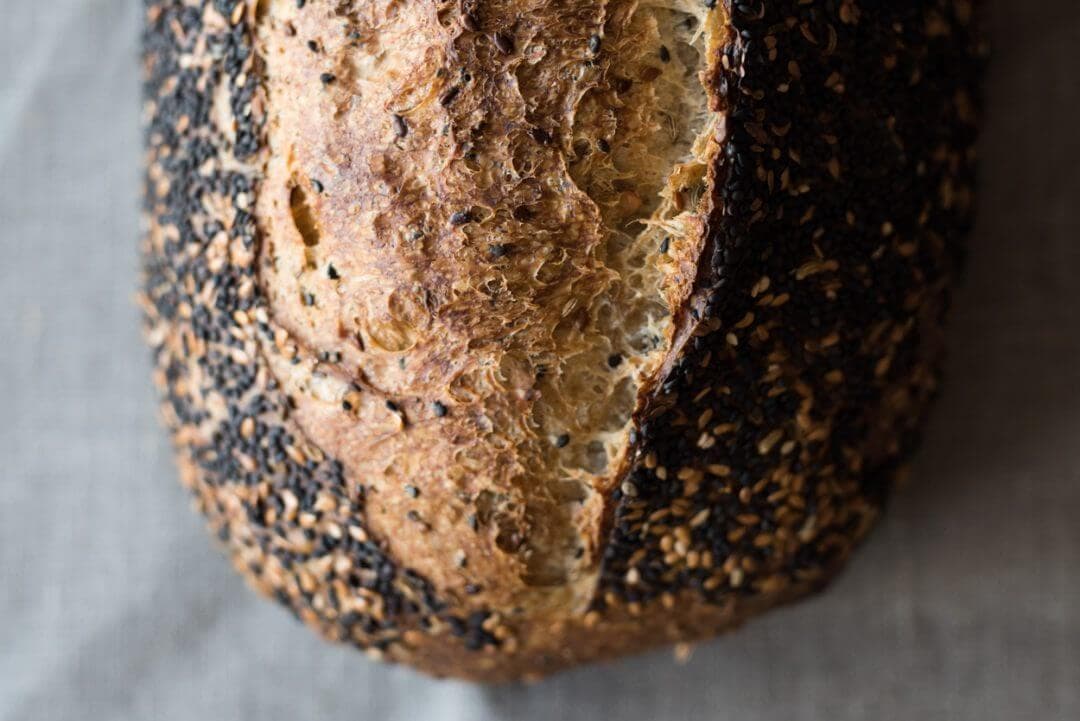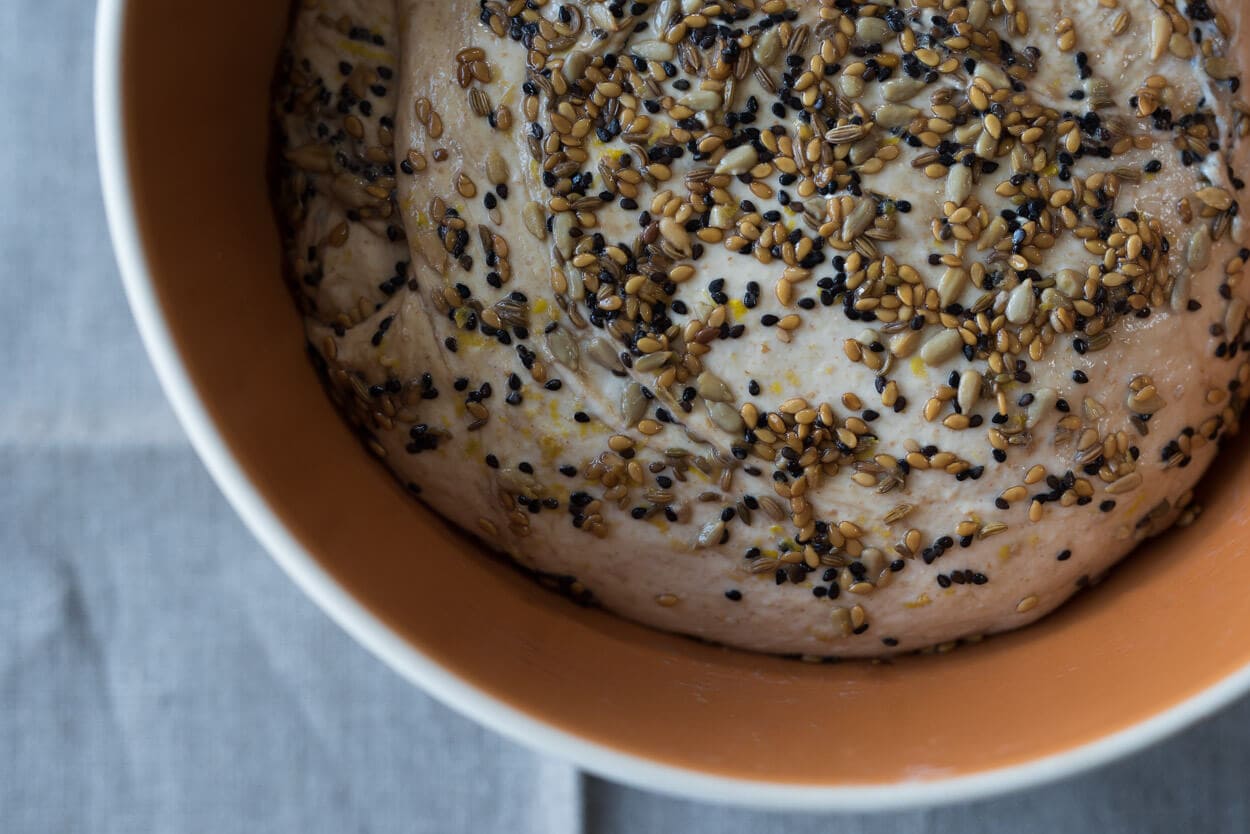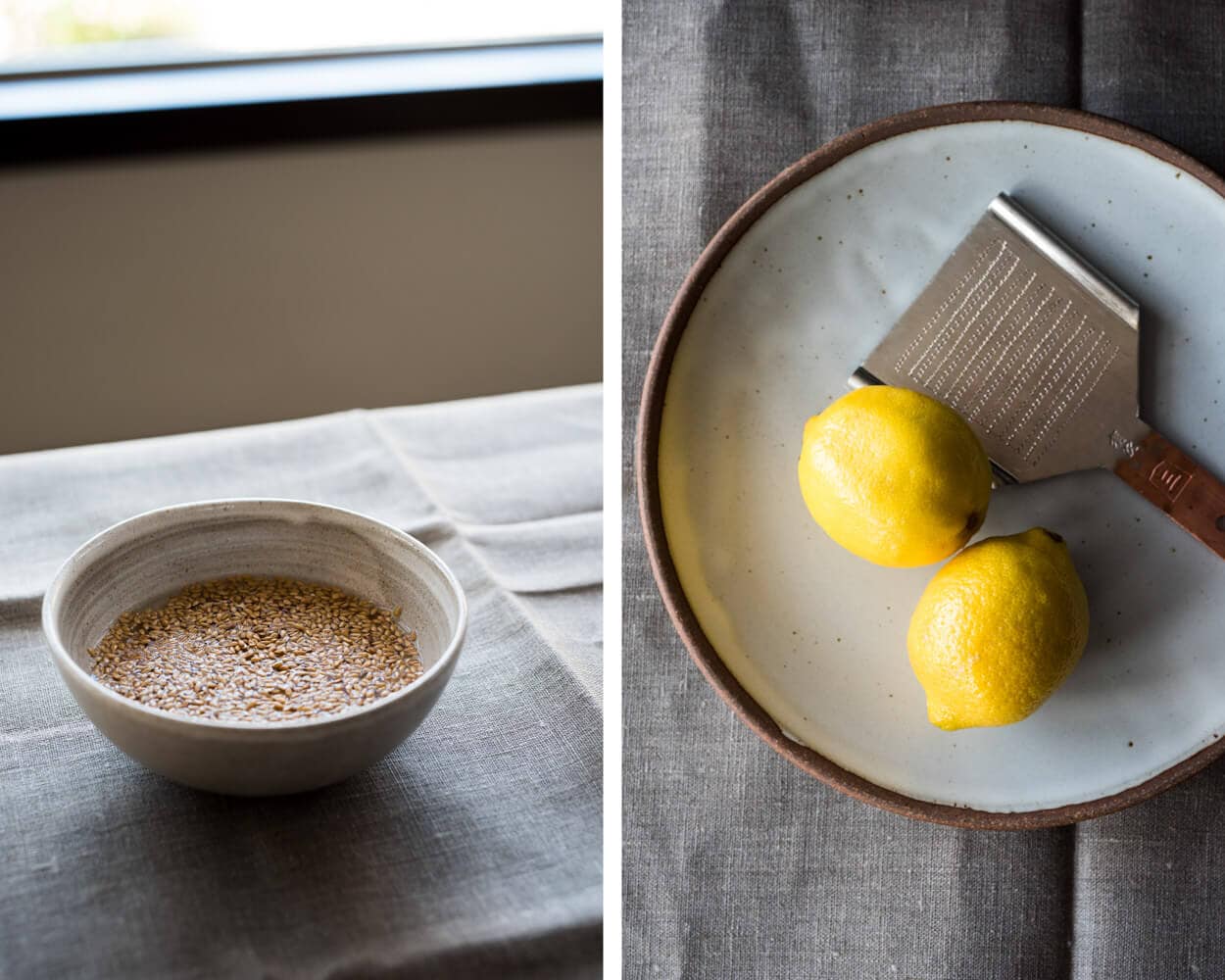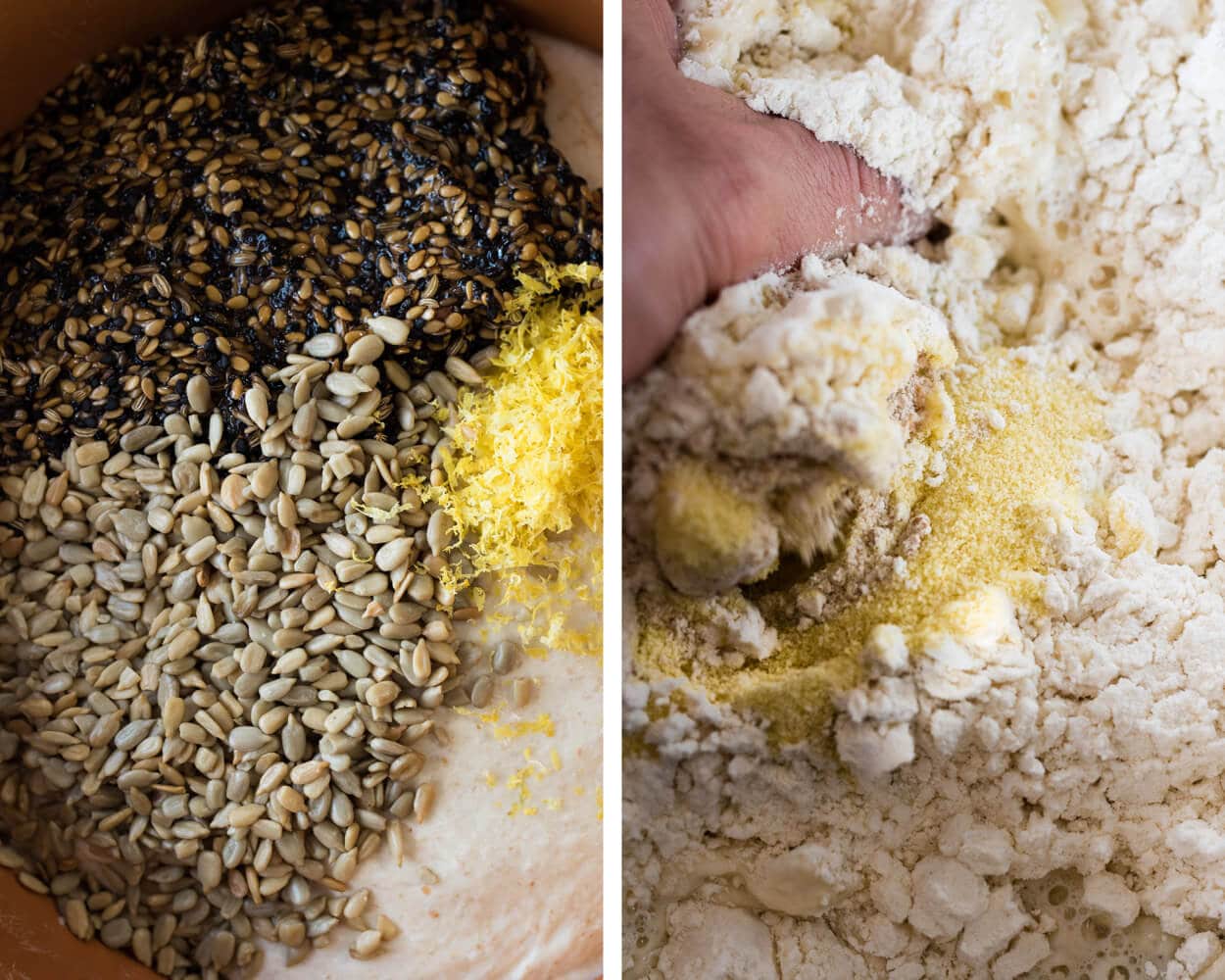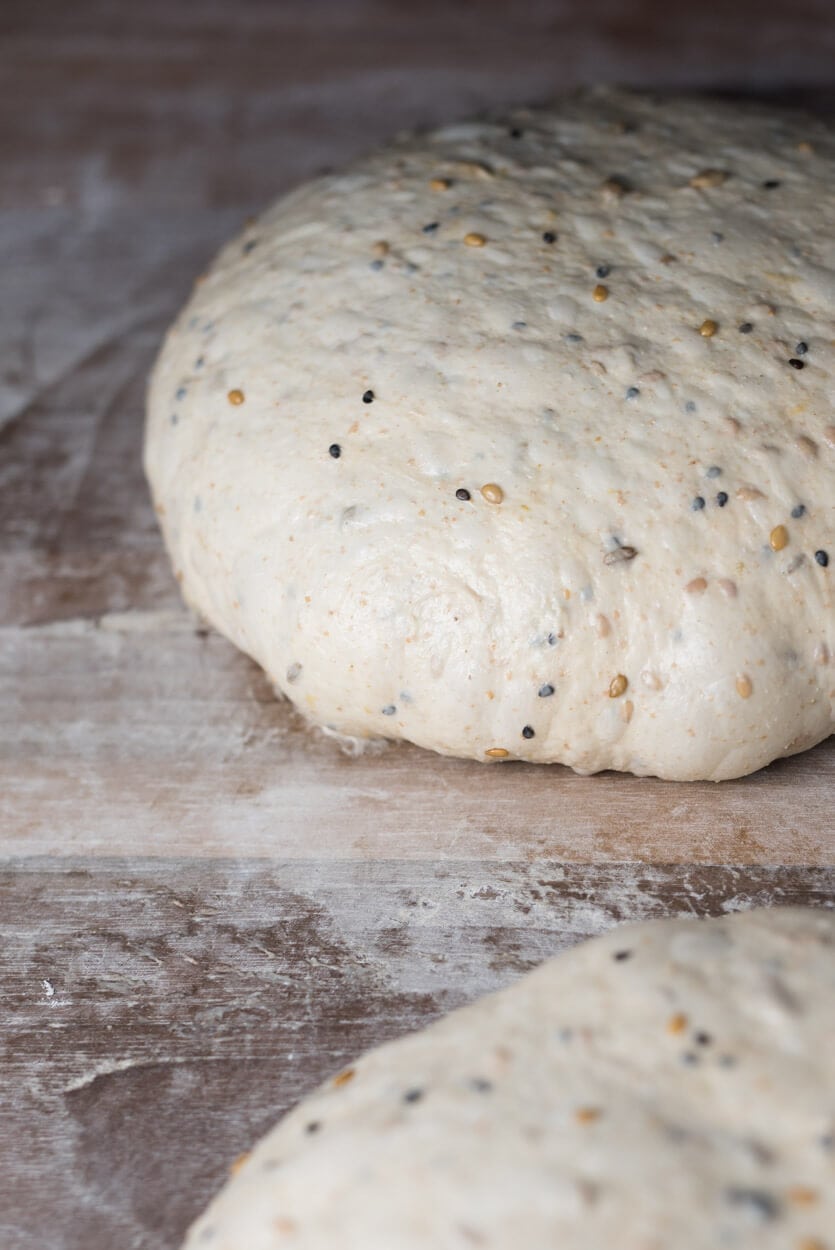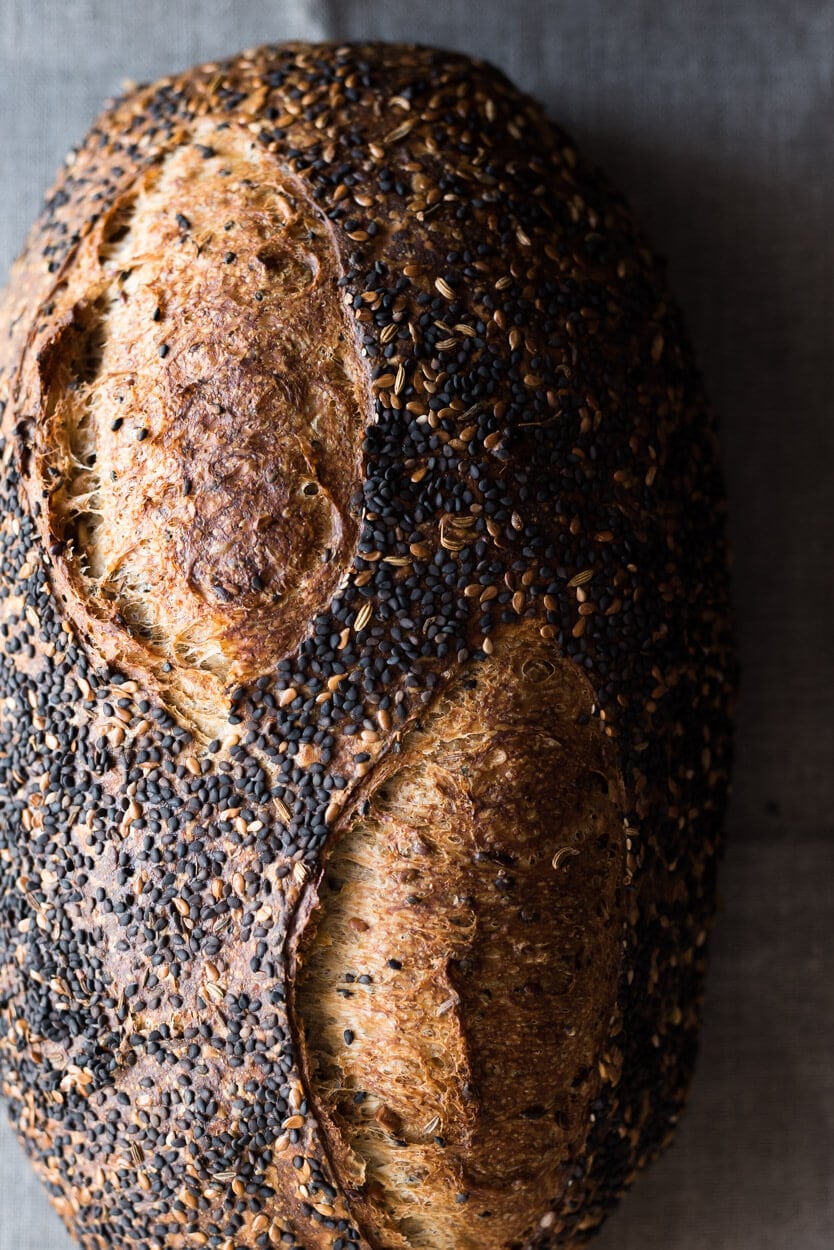The third anniversary for The Perfect Loaf just passed, and I felt like it was only fitting for me to revisit an old idea, an old recipe of mine for a seeded sourdough I posted a long, long time ago. I make this whole wheat version intermittently, and I enjoy it, but I wanted to explore some new flavors, textures, and techniques. I mean, after baking hundreds of loaves since the beginning days of this site, my process has changed and evolved quite a bit; perhaps it was time to take a new look at this old favorite.
Of course, there are endless combinations of seeds and spices one can bake into a loaf of bread, but finding just the right balance of flavors and textures can prove to be a challenging task. Personally, I find a lot of the seeded sourdough I try to be a little heavy with seeds; conceivably, I’m just more sensitive to the deep umami flavors of sesame, the spicy nature of flax, or the anise-like flavor of fennel, but I like to keep it light. Of course, there is a time and place for hearty bread, but I like my seeded sourdough a little more like a gentle peck and less like a heavy, flapping punch.
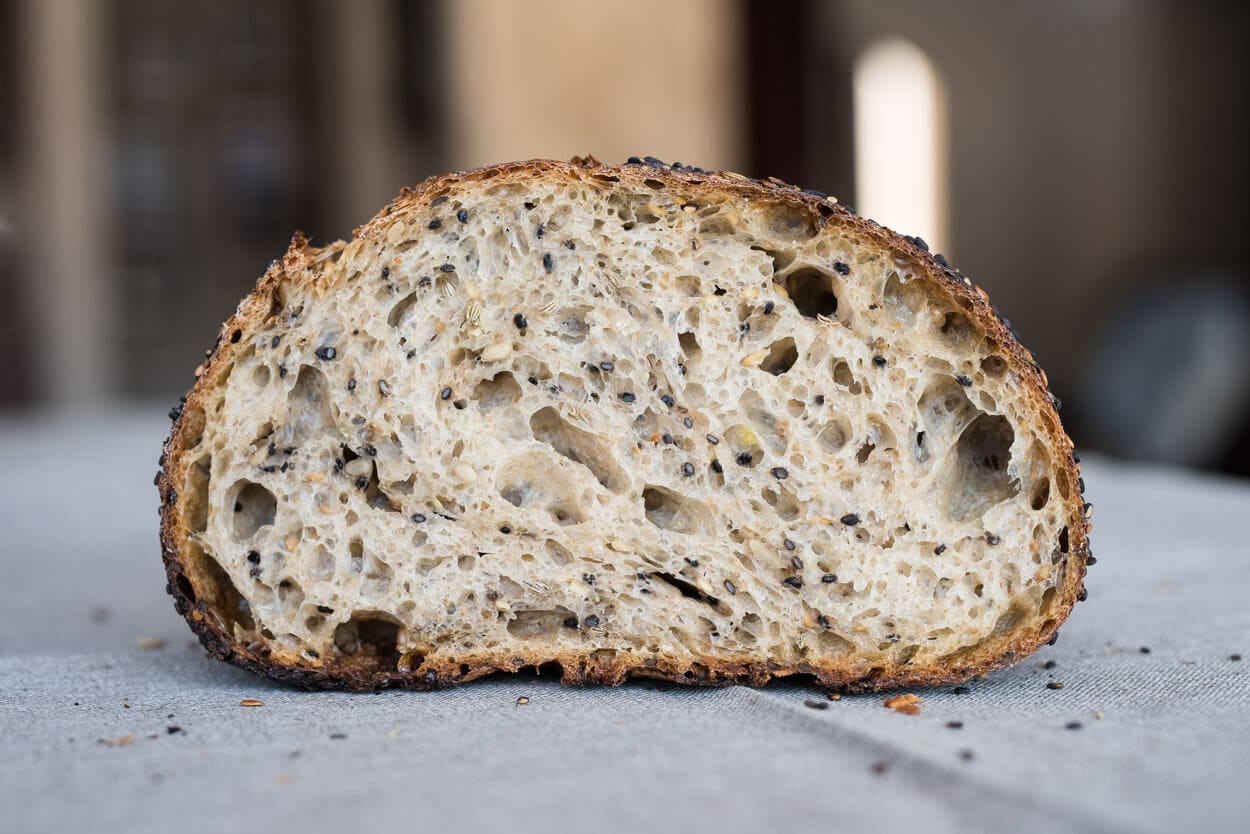
There’s no denying the additional health benefits seeds bring to bread, and that was one of the prompting factors for me to revisit the idea, but I also wanted to play with seed flavors instead of using them as an afterthought. Some seeds really work well together to play off of each other’s flavors, working in concert to give rise to an overall sense of good taste. The seeds chosen here are those that I personally feel go well together, but there are so many other combinations to be had—if desired, one can endlessly play the seed alchemist.
I’m not a big fan of caraway (it seems like this is a very polarizing flavor), and that’s why it’s not used here, but feel free to experiment with whatever seeds you might have in your pantry: caraway, poppy, white sesame, pumpkin, hemp and so on. Fennel is probably my favorite seed of them all; the bright, zesty flavor seems to go well with most things I make in the kitchen, and I had to include it here.
I know lemon zest is overused in baking and probably included in places where it really isn’t warranted, but it’s added here to help complement the multitude of seed flavors in this seeded sourdough bread. I found that sporadic bites would display a quick and mellow lemon flavor, which was a welcome surprise amidst the deep seed flavors’ backdrop. If you don’t have lemons on hand or feel the flavor isn’t necessary, then feel free to omit the zest; of course, it’s up to you.
When mixing this dough with my hands, I often found myself pausing to look at the snaking sea of black sesame, the golden, gritty semolina, and the garish shine of lemon peel and thought to myself: this is going to taste really, really good.
Flour Selection
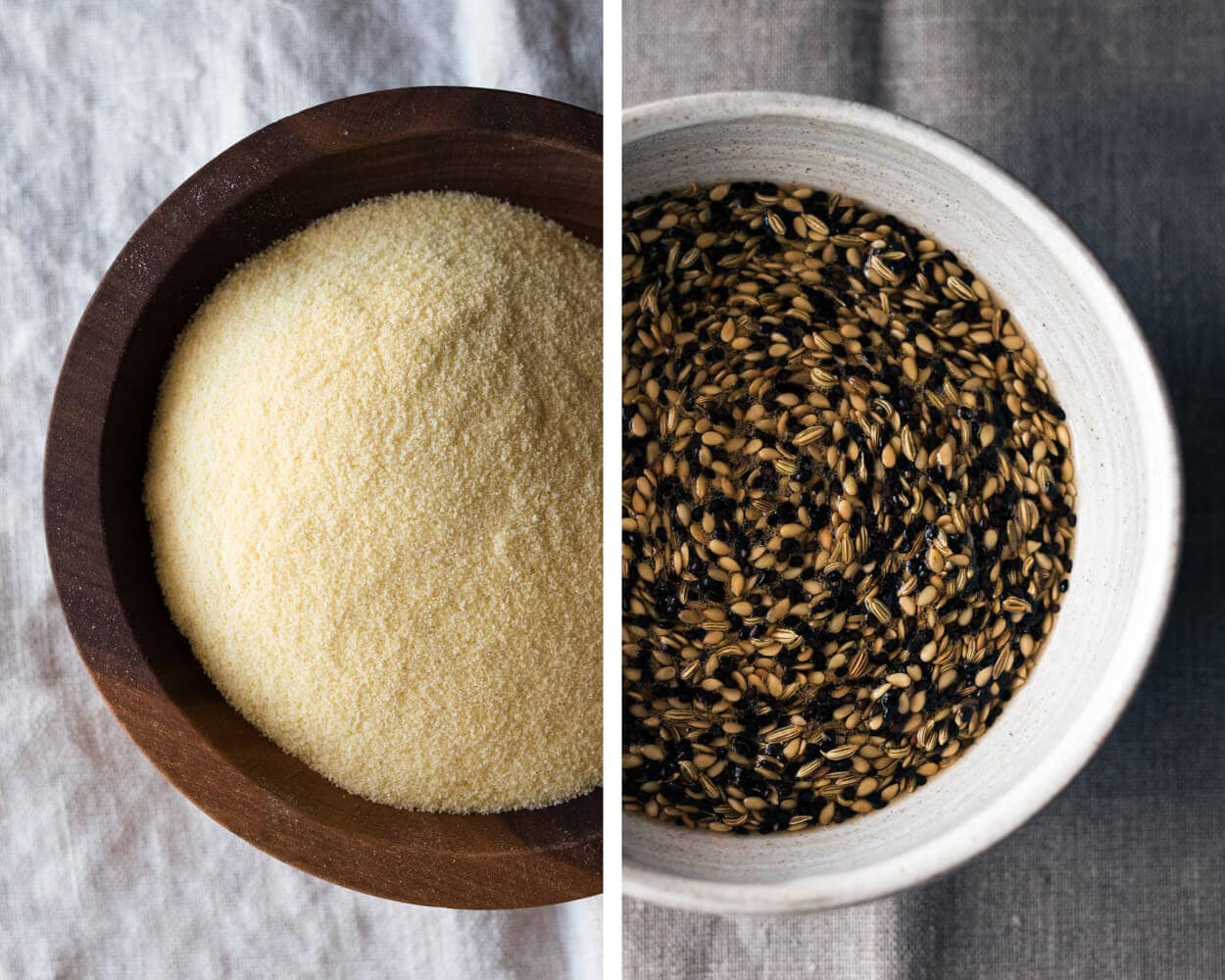
Lately, I’ve been making more and more fresh pasta at home, primarily comprised of coarse semolina flour milled from durum wheat, which has a higher-than-typical protein content. It’s a deep, luxurious yellow color and quite granular, similar to table salt. I like using this for pasta as it gives each bite a little more chew and a little density. For example, rolling thin is perfect for ravioli because you have two sheets of pasta pressed together with a filling. If the two sheets are too thick, you’ll end up tasting and chewing the pasta more than anything—you want the pasta to be thin but chewy/strong.
I added a fairly small percentage of semolina for this seeded sourdough bread, but the taste and texture are noticeable. It adds a little sweetness to help compliment all the robust seeds, and many say semolina helps attain a fragile and crunchy crust. I can say my outcome here doesn’t dispute that — the crust on my bakes have been fragile and cracker-like, how I like it; if you don’t have semolina at hand (durum works, of course), then substituting the semolina percentage in my formula for a stoneground or roller milled whole wheat. This replacement would add a level of flavor and strength to the dough and work quite well.
See my Pane Siciliano for another sourdough recipe using durum wheat →
Seeded Sourdough Formula
See my post on baker’s percentages for information on how to modify this formula.
| Total Dough Weight | 1800 grams |
| Pre-fermented Flour | 6.50% |
| Levain in Final Dough | 17.38% |
| Hydration | 83.00% |
| Yield | Two 900-gram loaves |
Total Formula
Target final dough temperature (FDT) is 78°F (25°C).
| Weight | Ingredient | Baker’s Percentage |
|---|---|---|
| 665g | Medium-protein bread flour (~11.5% protein, Giusto’s Artisan Bread Flour) | 75.00% |
| 133g | Semolina (coarsely milled Durum wheat) | 15.00% |
| 89g | Whole wheat flour (Giusto’s Stoneground Whole Wheat) | 10.00% |
| 40g | Flaxseed | 4.50% |
| 40g | Dark sesame seed | 4.50% |
| 40g | Sunflower seed, shelled (not roasted or salted) | 4.50% |
| 13g | Fennel seed | 1.50% |
| – | Zest of two lemons (optional) | – |
| 691g | Water 1 (soaker, levain, and autolyse) | 78.00% |
| 44g | Water 2 (mix) | 5.00% |
| 16g | Sea salt | 1.80% |
| 29g | Sourdough starter | 3.25% |
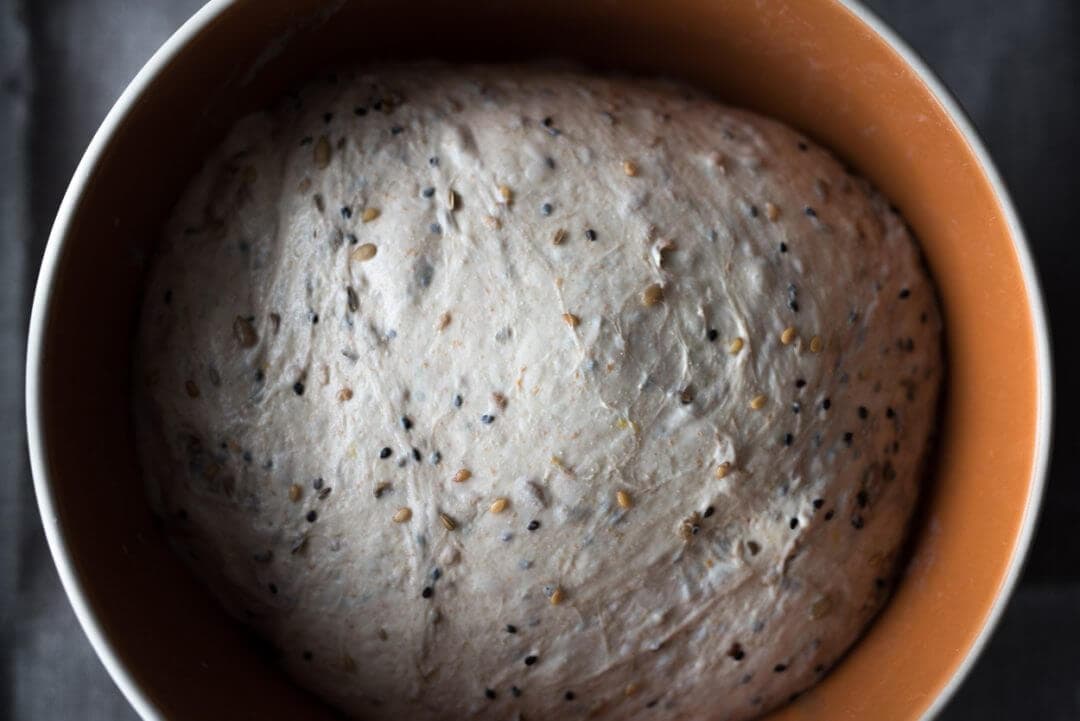
Seeded Sourdough Method
1. Levain – 9:00 a.m.
Mix the following ingredients in a container and leave covered to ripen at about 78°F (25°C) for 5 hours.
| Weight | Ingredient | Baker’s Percentage |
|---|---|---|
| 30g | Ripe sourdough starter (100% hydration) | 50% |
| 30g | Medium-protein bread flour (~11.5% protein, Giusto’s Artisan Bread Flour) | 50% |
| 30g | Whole wheat flour (Giusto’s Stoneground Whole Wheat) | 50% |
| 60g | Water 1 | 100% |
2. Prepare Seed Soaker – 9:10 a.m.
After you’ve mixed your levain, prepare the seed soaker. In a heatproof bowl (stainless steel is great), add the following seeds and boiled water (note the sunflower seeds are not added to the soaker).
Boil 175g of water in a kettle. Once boiling, turn off the heat and pour 133g of the hot water over the seeds in the heatproof bowl. Let this mixture soak until called for in the bulk fermentation step.
| Weight | Ingredient |
|---|---|
| 40g | Flaxseed |
| 40g | Dark sesame seed |
| 13g | Fennel seed |
| 133g | Water 1 |
3. Autolyse – 1:00 p.m.
Add the following to a mixing bowl and mix until all dry bits are hydrated. Cover bowl and store somewhere warm (around 78°F/25°C) for 1 hour.
| Weight | Ingredient |
|---|---|
| 636g | Medium-protein bread flour (~11.5% protein, Giusto’s Artisan Bread Flour) |
| 133g | Semolina (coarsely milled Durum wheat) |
| 60g | Whole wheat flour (Giusto’s Stoneground Whole Wheat) |
| 501g | Water 1 |
4. Mix – 2:00 p.m.
To the dough in autolyse, add the remaining water, salt, and levain.
| Weight | Ingredient |
|---|---|
| 44g | Water 2 |
| 16g | Sea salt |
| 144g | Levain (see Levain section, above) |
I chose to do slap and fold for about 5 minutes, just until the dough starts to show signs of a smooth surface and it’s catching some air. If you aren’t comfortable with the slap/fold method or don’t like it, you can perform stretch and folds in the bowl until your dough tightens up and slightly hard to stretch out and fold over—medium development.
Transfer dough to a tub or thick-walled bowl for bulk fermentation.
5. Bulk Fermentation – 2:10 p.m. to 5:40 p.m.
At 78°F (25°C) ambient temperature, bulk fermentation should go for around 3 1/2 hours. Keep an eye on the dough; for me, fermentation was moving rather rapidly, and the dough became extremely puffed up (see preshape photo below).
Perform a total of 4 sets of stretch and folds during the bulk, spaced out by 30 minutes.
Before the first set of stretch and folds, add the cooled seed soaker and optional lemon zest. I like to spread the mix-ins on top of the dough and then perform my stretch and folds to help the ingredients distribute. They will further distribute through the dough with each subsequent set of stretch and folds.
6. Divide and Preshape – 5:40 p.m.
Gently scrape your dough from the bulk container onto an un-floured work surface. Preshape the dough into two round boules and let rest 30 minutes uncovered.
You can see the significant activity in my dough; it was seriously jiggly and quite puffed.
7. Shape – 6:10 p.m.
To coat the outside of your loaves with seeds (optional) as I’ve done, lay out a towel next to the shaping area that’s covered with a seed mixture. Take equal parts raw black sesame, flax, and fennel, and mix in a bowl. Spread this mixture out in the center of the towel evenly into a thin but cohesive layer. I didn’t include sunflower seeds in this mixture as I prefer the look of this bread with only small seeds on the exterior—personal preference. After the dough is shaped, we will quickly roll the top of each batard or boule in this mixture.
I shaped these loaves following my guide to shaping a batard.
Once you’ve shaped your dough, lightly spritz the top with a water mister, this helps the seeds stick to the exterior. Then, using your bench knife, scoop up your dough and invert it, so the seam side is facing up onto the towel with the seed mixture. Roll it around gently to coat and then transfer seam-side-up to your final proofing basket.
8. Rest & Proof – 6:20 p.m.
Cover your baskets with plastic and then retard in the refrigerator at 38°F (3°C) overnight. Even at such cool temperatures this dough can quickly overproof so keep an eye on it in the fridge in the morning. By the morning my dough was very gassy and had risen quite a bit in the fridge.
9. Bake – Next Morning: Preheat oven at 8:00 a.m., Bake at 9:00 a.m.
I steamed my oven in my usual way, described here in my post on how to steam your home oven for baking.
Preheat your oven to 450°F (230°C).
Scoring this bread can be difficult because the seeds form a hard crust on the outside. Get the blade into the dough and move quickly down to make a score. If the blade slips out of the cut, just continue where it left off and keep it going.
To make a double-score, make two straight, vertical slashes on the top of the dough, as you see below. The top one starts near the top-left of the dough and goes down halfway; the second one starts a little higher than where the first one left off and goes down straight almost to the loaf’s bottom. To visualize this, hold your two index fingers out in front of you, so the tops of your fingers are at the same height. Then shift your right hand down until your right fingernail lines up with your left finger’s middle joint—your two scores are the entire length of your index fingers.
Bake the dough for 20 minutes, then remove the steaming pans from inside the oven. Then, bake for an additional 30-35 minutes until done to your liking. Remove from the oven and cool on a wire rack for at least 1-2 hours. Be sure to store your bread properly to extend its life.
Conclusion
This seeded sourdough is such a great departure from weekly whole wheat or white sourdough; it brings deep flavors and interest to each slice. The interior bakes to a custard-like texture, while the crunch from the semolina-infused crust and densely woven seed mixture give a wonderful contrast. When toasted, I find the flavors actually amply further and the bread, specifically the crumb, takes on another level of brittleness that crackles constantly. It’s exemplary with good quality cultured butter and cheeses of all types (more below).
Crust
The dark, tawny crust is thin and crunchy; it feels like this seeded sourdough bread was wrapped tightly in a splintery cracker. The semolina has to play a role here, as does the high hydration and further impacted by the seed soaker. Speaking of seeds, the ominous look of the dark seeded exterior is a sight to behold. I showed these loaves to a few family members, and their initial reaction is always: “wow, that’s beautiful.” I have to say, though, the only downside to these seeds and cracker-like crust: a messy kitchen after slicing. Worth it!
The crust has to be one of my favorite parts of this seeded sourdough, but then there’s the crumb.
Crumb
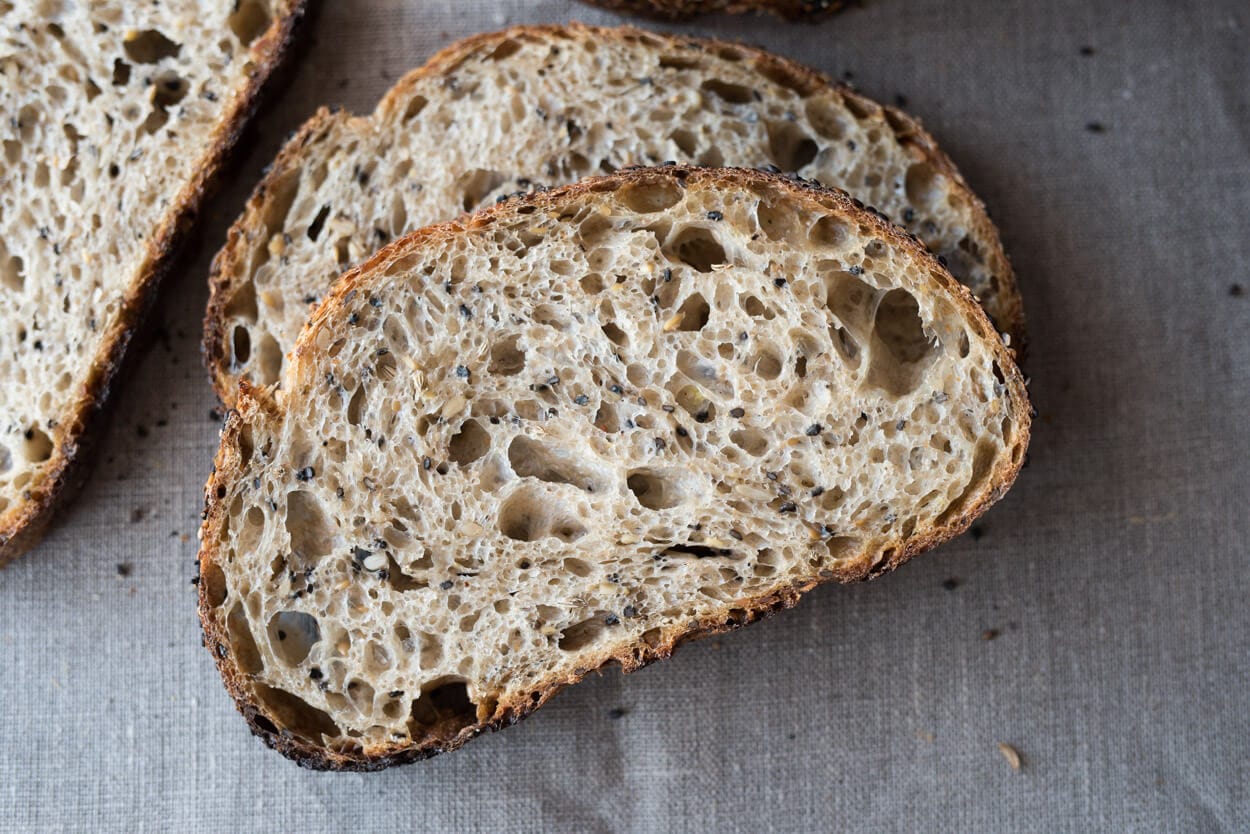
At the beginning of this post, I mentioned that finding the right texture for this type of bread can be challenging. I went heavy with the proof and pushed it as far as I felt possible. The dough was incredibly gassy and light, and this shows here in the interior. The entire loaf was very well fermented, extremely tender, and gelatinized through and through. I found that this bread’s soft, succulent interior works really well with the seeds and crust.
Taste
When you first see the outside of one of these loaves from the oven, you might think this bread is going to be way too flavor-forward, but as I said, in the beginning, I wasn’t looking for that with this formula. The loaf seems imposing, yes, even the interior, but when you taste it, you’ll see it’s more subtle than initial thoughts might indicate. Not including seeds like caraway, the loaf has just nudges of the seed flavors but nothing overpowering.
As mentioned earlier, I had a slice spread with a mixture of goat cheese, crushed pink peppercorn, lemon zest, and a drizzle of Amabile extra virgin olive oil2 that was just out of this world. The seeds’ hearty flavors were balanced by the citrus flavors, mellow goat cheese, and fruity olive oil—I could live on this seeded sourdough bread.
Buon appetito!
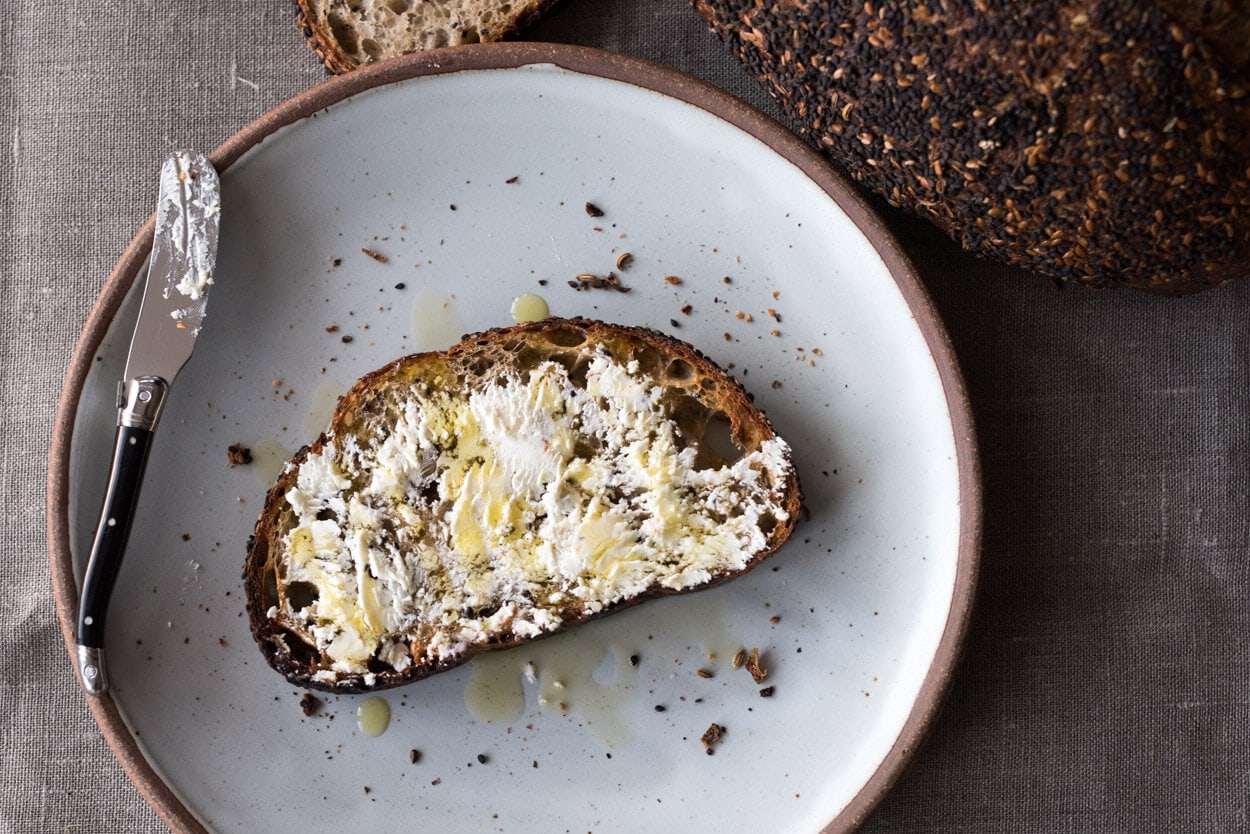
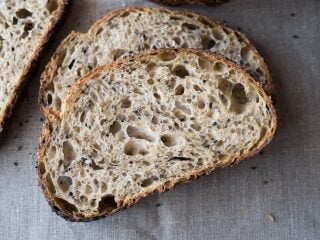
Seeded Sourdough Recipe
- Author: Maurizio Leo
- Prep Time: 24 hours
- Cook Time: 1 hour
- Total Time: 25 hours
- Yield: 2 loaves
Description
This seeded sourdough is such a great departure from weekly whole wheat or white sourdough; it brings deep flavors and interest to each slice. The interior bakes to a custard-like texture, while the crunch from the semolina-infused crust and densely woven seed mixture give a wonderful contrast. When toasted, I find the flavors actually amply further and the bread, specifically the crumb, takes on another level of brittleness that crackles constantly. It’s exemplary with good quality cultured butter and cheeses of all types.
Ingredients
Seed Soaker
- 40g flaxseed
- 40g dark sesame seed
- 40g sunflower seed, shelled, not roasted, unsalted
- 13g fennel seed
- 133g water, boiled
Levain
- 30g medium-protein bread flour
- 30g whole wheat flour
- 30g ripe sourdough starter
- 60g water
Autolyse
- 636g medium-protein bread flour
- 133g semolina
- 60g whole wheat flour
- 501g water
Final Mix
- 16g sea salt
- 144g ripe levain (from Step 1)
- 44g water
Instructions
- Levain (9:00 a.m.)
In a small container, mix the Levain ingredients and keep at 78°F (25°C) for 5 hours. - Prepare Seed Soaker (9:10 a.m.)
Add the Seed Soaker ingredients (except the sunflower seeds) to a heatproof bowl and let soak until called for in bulk fermentation. - Autolyse (1:00 p.m)
In a medium mixing bowl, add the Autolyse ingredients and mix until no dry bits remain. Cover the bowl and let rest for 1 hour. - Mix (2:00 p.m.)
To the mixing bowl holding your dough, add the Final Mix ingredients and mix to incorporate. Then, strengthen the dough for another 5 minutes until smooth and elastic. Transfer your dough to a bulk fermentation container and cover. - Bulk Fermentation (2:10 p.m. to 5:40 p.m.)
Give the dough 4 sets of stretch and folds at 30-minute intervals, where the first set starts 30 minutes after the start of bulk fermentation. Before the first set of stretch and folds, spread the seed soaker, sunflower seeds, and lemon zest (optional) over the dough. Each set of folds will help incorporate the mixture into the dough. - Divide and Preshape (5:40 p.m.)
Lightly flour your work surface and scrape out your dough. Using your bench knife, divide the dough in half. Lightly shape each half into a round shape. Let the dough rest for 30 minutes, uncovered. - Shape (6:10 p.m.)
Shape the dough into a round (boule) or oval (batard), top with a mixture of sesame, flax, and fennel, and place in proofing baskets. - Rest and Proof (6:20 p.m. to 9:00 a.m. the next day)
Cover proofing baskets with reusable plastic and seal them shut. Then, place both baskets into the refrigerator and proof overnight. - Bake (Preheat oven at 8:00 a.m., bake at 9:00 a.m.)
Preheat your oven with a combo cooker or Dutch oven inside to 450°F (230°C). When the oven is preheated, remove your dough from the fridge, score it, and transfer it to the preheated combo cooker. Place the cooker in the oven, cover with the lid, and bake for 20 minutes. After this time, remove the lid (you can keep it in the oven or remove it) and continue to bake for 30 minutes longer. When done, the internal temperature should be around 208°F (97°C). Let the loaves cool for 2 hours on a wire rack before slicing.
If you use this recipe, tag @maurizio on Instagram so I can take a look!
What’s Next?
If you loved this seeded sourdough, check out its distant cousin: a sunflower and sesame sourdough bread with an added touch of honey for a little sweetness. It’s a delicious loaf—I’d be hard-pressed to decide between baking either of these!
Or, if you’re looking to use more durum wheat, my Pane Siciliano recipe calls for 100% durum and is topped with white sesame seeds.


